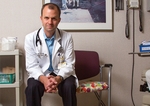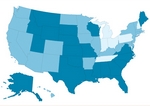business
Meaningful use checks begin to arrive
■ An Oklahoma practice is the first to receive bonus money tied to physicians' adoption of electronic medical records.
By Pamela Lewis Dolan — Posted Jan. 24, 2011
- WITH THIS STORY:
- » Related content
The physicians at the Gastorf Family Clinic in Durant, Okla., recently received a ceremonial oversized check, as if they had won the Publishers Clearing House sweepstakes.
Instead, the husband-and-wife physician team of Jeffrey Gastorf, DO, and Melissa Gastorf, DO, were the center of attention for being the first doctors to collect bonuses under a federal incentive plan to encourage the use of electronic medical records. The two family physicians individually received real checks -- technically, direct deposits into their bank accounts -- for $21,250 each. But they also got a visit from officials at the agency that runs Oklahoma's Medicaid program, who brought the oversized check.
The check delivery marks the official kickoff of payments from the Centers for Medicare & Medicaid Services' meaningful use incentive program, which rewards physicians for their use of EMRs, as long as that use meets certain standards. The first payments, in 2011, represent stage 1 of a multiyear process. If things go according to plan and the Gastorf Clinic meets requirements for the next stages of meaningful use, it could be among the practices that collect up to $63,750 per doctor during the next six years.
For physicians who meet the required objectives under Medicare, the total would be up to $44,000 over five years. Practices cannot collect bonuses under both programs, which were created by the 2009 economic stimulus package.
Not all states were ready to participate in the Medicaid incentive program on its Jan. 3 start date, according to CMS. Eleven states were ready in January, and three more will begin in February. Other states are expected to launch their programs during the spring and summer. States are responsible for distributing payments to practices.
As of Jan. 6, more than 4,000 physicians or other health care professionals had registered for the incentive program.
EMR bought 5 years ago
For the Gastorf Clinic, with more than half of its patient population on Medicaid, the money comes more than five years after the practice made a $27,000 investment in a server-based EMR system. Ongoing costs are about $10,000 a year.
When the meaningful use incentives were announced, the clinic's practice manager, Darrell Ledbetter, knew immediately that the practice should apply. The Gastorf Clinic began working with the Oklahoma Foundation for Medical Quality, the designated regional extension center for that state, in preparation. RECs are the federally designated organizations meant to help physician practices choose and implement EMRs with the goal of meeting meaningful use.
The clinic needed to make minor upgrades and changes to the EMR software, which it did right away. And then it waited.
In late 2010, the Oklahoma Health Care Authority, which oversees the Medicaid program in that state and is responsible for distributing incentive money, contacted Ledbetter and said the Gastorf Clinic often was mentioned because of its relationship with the Oklahoma REC. The health authority asked if the clinic would like to be the first in the state to receive Medicaid incentive money, but neither the clinic nor the authority knew Gastorf would be the first in the country to receive a check.
Jonathan Kolarik, RN, director of health information technology for the Oklahoma REC, said his group, like many RECs, has found recruiting physicians quite challenging. Each REC is responsible for contracting with about 1,000 practices, or 20% of the practices in their region, over two years. Kolarik hoped that because one of his clients was the first to receive the money, others will be encouraged to go after the incentive money as well. Of those already enrolled, he said, several will get their stage 1 incentive checks soon.
Encouraging news for vendors
Michael Stearns, MD, president and CEO of e-MDs, the EMR vendor used by the Gastorf Clinic, said it was encouraging for the entire vendor community to see checks being cut so soon, especially for those qualifying for the Medicaid incentives.
Unlike the Medicare arm of the program, the Medicaid incentive program does not require actual use of an EMR system to qualify for stage 1. Practices need only a contract showing that an EMR investment will be made. For many, the first incentive check probably will be the needed capital actually to purchase one.
For practices like Gastorf that already have made the investment, "it's like a windfall," Dr. Stearns said.
Ledbetter said the money probably will be used to purchase new computers and a new server, which, after five years, are nearing the end of their life expectancies.
In addition to Oklahoma, the Kentucky Medicaid program also cut two incentive checks. UK Healthcare, a hospital system based at the University of Kentucky in Lexington, received a check for $2.8 million. Central Baptist Hospital, also in Lexington, received $1.3 million.
Hospital incentives, which could total several million dollars for each qualified hospital over six years, are based on a combination of several factors and formulas.
So what does one do with an oversized check for $42,500? Ledbetter said Dr. Jeffrey Gastorf joked about taking it to the drive-through lane at the bank and trying to cram it into the pneumatic tube to deposit it. Instead, it ended up displayed on a wall in his office.












